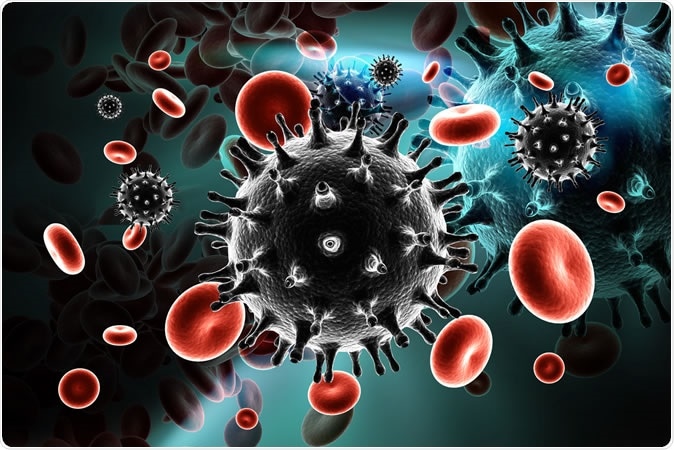There are millions living with HIV and researchers have been working towards making a successful vaccine against the deadly infection for the past 35 years with no success. Now a new blueprint is being developed to prevent the infection.
A team of researchers from Duke University and Harvard have worked towards making a vaccine that can imitate a rare process in the immune system that is seen in persons with HIV. This process can help reduce the viral load of the body, explain the researchers.
The study results were published in the latest issue of the journal Science.

Digital illustration of HIV Virus in Blood Stream. Image Credit: RAJ CREATIONZS / Shutterstock
Researchers warn that this may be the first step in the development of an effective vaccine against the infection and there may be many bridges to cross before the final vaccine is ready for human use and is tried in large scale clinical trials.
Barton Haynes, director of the Duke Human Vaccine Institute, who was the lead author of the study said in a statement, “For the first 20 years after the virus was discovered, the field tried to make a vaccine using the techniques that all the successful measles, mumps, rubella, polio vaccines had been made within the past. And none of those worked.” He explained that the virus is constantly changing and thus every vaccine developed failed to generate antibodies that could fight the infection off.
The researchers explained in their work that in around 20 percent of the persons infected with HIV, the immune system makes a special protein called “broadly neutralizing antibodies” (bnAbs). These antibodies are powerful enough to remove the viruses in regions that remain same despite mutations. This means that the HIV may mutate but the antibodies would still be able to attack and remove them and not allow the viruses to replicate. These antibodies cannot cure a person with HIV however because some reservoirs of viruses remain within certain cells where the antibodies fail to reach them.
There have been studies where animal models of HIV have been injected with these antibodies and results showed that new infections could be prevented by these injections. This protection however did not last and was too short lived explain the researchers. To make an effective vaccine the researchers needed a shot that would provide long term protection from HIV infection.
Thus for this new study the team used technology of computer modelling and followed it up with lab testing to see if the mice and monkeys could train their immune systems to create these antibodies and fight off the infection. Haynes said, “We show a new way to design the HIV vaccine to guide the broadly neutralizing antibodies to go down paths they rarely go down on their own.”
They wrote that they “hypothesized that vaccination with immunogens that bind with moderate to high affinity to bnAb B cell precursors, and with higher affinity to precursors that have acquired improbable mutations, could initiate bnAb B cell lineages and select for key improbable mutations required for bnAb development.” They wrote in their results section, “...our immunogens elicited antibody responses in macaques and knock-in mice that exhibited the mutational patterns, structural characteristics, or neutralization profiles of nascent broadly neutralizing antibodies.”
They first designed HIV-1 envelope immunogens (moieties that could mimic the cover of an HIV-1 virus and stimulate the immune response). These immunogens were bound to bound precursor B cells at the CD4 binding site or else at the V3-glycan bnAb lineage. They then vaccinated lab macaques with the CD4 bound antibodies, They also used genetically modified mice called “knock in mice”. These mice had genes to secrete the needed bnAb. From these mice the isolated bnAbs were found to neutralize the HIV-1 global isolates. These bnAbs were found to kill the HIV-1 isolates despite their mutations, the team noted.
Other experts have lauded this approach saying that the body would be the best manufacturer of the antibodies that could fight off the HIV infection. This work is one third completed with development of essential antibodies that could fight off the infection. They hope to soon have the tools for an effective HIV vaccine.
The team wrote in conclusion, “...this study demonstrates a rational strategy for sequential immunogen design to circumvent the difficult roadblocks in HIV-1 bnAb induction by vaccination...This strategy of selection of specific antibody nucleotides by immunogen design can be applied to B cell lineages targeting other pathogens where guided affinity maturation is needed for a protective antibody response.”
Dr. John Mascola, director of the Vaccine Research Center at the National Institutes of Health (NIH) in a statement said that this new vaccine could be 80 to 90 percent effective and estimates that it would be ready for trials in large clinical trials in another five years.
Journal reference:
Targeted selection of HIV-specific antibody mutations by engineering B cell maturation, Kevin O. Saunders, Kevin Wiehe, Ming Tian, Priyamvada Acharya1, Todd Bradley, S. Munir Alam, Eden P. Go, Richard Scearce, Laura Sutherland, Rory Henderson, Allen L. Hsu, Mario J. Borgnia, Haiyan Chen, Xiaozhi Lu, Nelson R. Wu, Brian Watts, Chuancang Jiang, David Easterhoff, Hwei-Ling Cheng, Kelly McGovern, Peyton Waddicor, Aimee Chapdelaine-Williams, Amanda Eaton, Jinsong Zhang, Wes Rountree, Laurent Verkoczy, Mark Tomai, Mark G. Lewis, Heather R. Desaire, Robert J. Edwards, Derek W. Cain, Mattia Bonsignori, David Montefiori, Frederick W. Alt, Barton F. Haynes, Science 06 Dec 2019: Vol. 366, Issue 6470, eaay7199, DOI: 10.1126/science.aay7199, https://science.sciencemag.org/content/366/6470/eaay7199